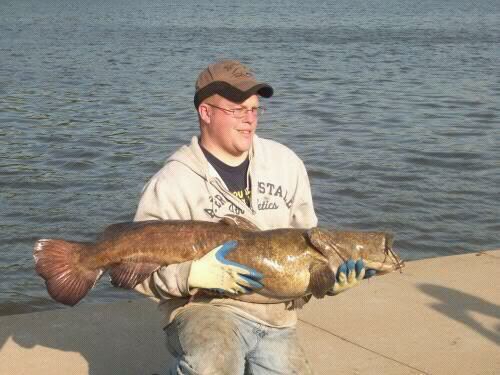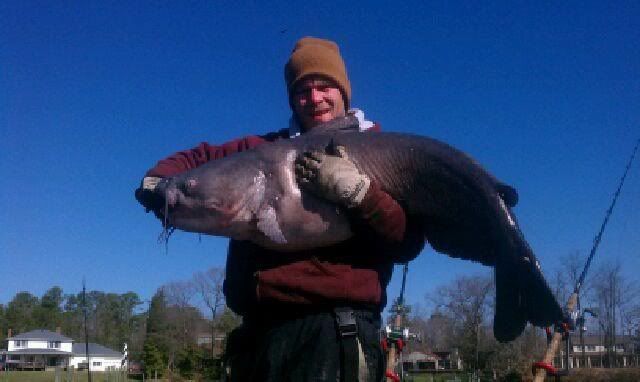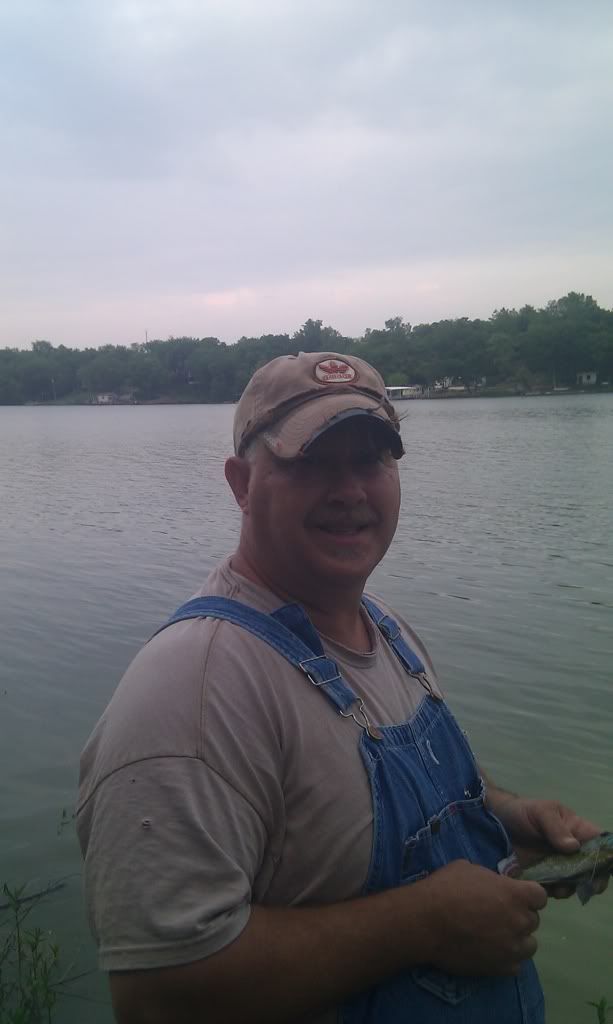Post by Smoothkip on Jan 2, 2012 23:26:17 GMT -5
Found an old article on my computer that Catfishrollo wrote up quite a few years ago on lake flatheads, figured there was a lot of good info for beginner lake flathead fisherman to know where to start.
This is a topic not much discussed by those that fish for flatheads on the lakes including myself, because of the attention drawn to areas, spots, etc. However, I have decided to to talk alittle on how I target these fish, and even somethings that I look for when arriving on the water to help those that have an interest in chasing them on the lakes. First thing, if you aren't a patient fisherman, then this type of fishing isn't for you. Flatheads on lakes can be very frustrating. They can be very difficult to pinpoint, and when you stumble upon one, you can fish many more nights before you will get the opportunity to catch another. A good night on a typical river for me is a five-fish night. A good night on a lake is hearing a clicker take off once or twice from dusk till dawn. Or catching two fish. So maybe that sets the idea alittle better. However, the size of the fish you will catch on a good flathead lake seems to be much larger than an average on a river. I dunno why this is yet, but fish in the teens or single digits seem not to be caught often. Two years ago we carried around a 26 pound average, biggest that year was a 47 pound fish, with a couple others in the 40's etc. So for your time spent, the results can be rewarding. When arriving to a lake, it can be very overwelming on where to go, or what to look for with the large impoundment of water. So it is very important to study maps before hand, and utilize them to learn creek channels, depth changes, and even some manmade structure areas to give you a better idea where to target when you get there. One thing we have learned is flatheads love to use the creek channels to travel! The creek channel doesn't have to be deep either. You can take a fairly shallow area, and the creek channel may only be a couple feet deeper, but they will use the channeling areas to move to and from feeding zones. Places I like to look for are where the creek channels come in from the main-lake and swing in towards a point, cove, or any other area that seems to be a landmark different from the surrounding shorelines. This is where a map can help. Take a highlighter, and mark these on your map!:wink: When you get to the lake it will help you in finding the location to look for on the depthfinder, and chosing a location to fish!! Flatheads will move up on these shallow flats at night time to feed on baitfish. We always use our boat just to go to a destination of choice, then we setup on the bank to fish. One thing I have learned, is most lakes after dark usually settle down in stabile weather patterns creating very calm water. If you are fishing from a boat, there is a good possibility you are gonna spook these fish by clanking around etc. So setting up from the bank allows you to blend into their enviroment better, especially in shallow water. We place our livebaits under large floats, and cast them out along the creek channel. A good way to remember the creek channel is take a marker bouy that bass fishermen often use, and put a glowstick on them. As you make your passes in the boat earlier in the eveing, and mark this creek channel on the depthfinder, drop them along the edge so after dark you have a landmark to cast to. Anyways, once setup on the bank we seperate our poles allowing for plenty of area between rods. The livbaits usually swim around, and by placing them too close together can cause for a disaster after dark. We often use glowsticks on our floats. I was weary of this at first, but the fish don't seem to mind the glow. Other places to look for on lakes are any structure areas, whether it be wood or rocks. Flatheads still cling to structure like river flatheads often do. So if you see a sunken tree coming off the bank, stump, or maybe a manmade structure such as sunken christmas trees or rip rap rock, chance are they are gonna be places a flathead are gonna lurk and check out sooner or later for baitfish etc. Now, the baitfish. As the water warms in the spring-time, many other species get ready for spawn. Crappies and gills will start moving from the deeper water to these shallow flats when the water temps. break into the 50 degree range. By the mid 50's into the 60's they often are getting ready for spawn. Once water temps break into the low to mid 60's they are spawning on these shallow spawning beds. Why is this important? Well, this is when the water temps. are getting right for the flatheads to start eating well also. If you can locate the baitfish, look for the travel zone I talked about earlier, and setup close to both, chances are you are gonna be in the area code of the big boys! Lake flatheads act different than river flatheads to an extent. They don't have the current to fight, they probably can't ambush fish as easily due to the lack of structure. But, the bottom line is they are still a predative fish. You have to work alittle harder to find them, but they will still eat with the same ambition as the river fish. These are a few hints to help those wanting to target lake flatheads, by no means is this the only way to target them. These are just a few things I look for, and what has worked so far in my chasing. I look forward to learning from added responses here as well. We can never learn, or know to much when it comes to flatheads. Goodluck, and hope this helps some......rollo
This is a topic not much discussed by those that fish for flatheads on the lakes including myself, because of the attention drawn to areas, spots, etc. However, I have decided to to talk alittle on how I target these fish, and even somethings that I look for when arriving on the water to help those that have an interest in chasing them on the lakes. First thing, if you aren't a patient fisherman, then this type of fishing isn't for you. Flatheads on lakes can be very frustrating. They can be very difficult to pinpoint, and when you stumble upon one, you can fish many more nights before you will get the opportunity to catch another. A good night on a typical river for me is a five-fish night. A good night on a lake is hearing a clicker take off once or twice from dusk till dawn. Or catching two fish. So maybe that sets the idea alittle better. However, the size of the fish you will catch on a good flathead lake seems to be much larger than an average on a river. I dunno why this is yet, but fish in the teens or single digits seem not to be caught often. Two years ago we carried around a 26 pound average, biggest that year was a 47 pound fish, with a couple others in the 40's etc. So for your time spent, the results can be rewarding. When arriving to a lake, it can be very overwelming on where to go, or what to look for with the large impoundment of water. So it is very important to study maps before hand, and utilize them to learn creek channels, depth changes, and even some manmade structure areas to give you a better idea where to target when you get there. One thing we have learned is flatheads love to use the creek channels to travel! The creek channel doesn't have to be deep either. You can take a fairly shallow area, and the creek channel may only be a couple feet deeper, but they will use the channeling areas to move to and from feeding zones. Places I like to look for are where the creek channels come in from the main-lake and swing in towards a point, cove, or any other area that seems to be a landmark different from the surrounding shorelines. This is where a map can help. Take a highlighter, and mark these on your map!:wink: When you get to the lake it will help you in finding the location to look for on the depthfinder, and chosing a location to fish!! Flatheads will move up on these shallow flats at night time to feed on baitfish. We always use our boat just to go to a destination of choice, then we setup on the bank to fish. One thing I have learned, is most lakes after dark usually settle down in stabile weather patterns creating very calm water. If you are fishing from a boat, there is a good possibility you are gonna spook these fish by clanking around etc. So setting up from the bank allows you to blend into their enviroment better, especially in shallow water. We place our livebaits under large floats, and cast them out along the creek channel. A good way to remember the creek channel is take a marker bouy that bass fishermen often use, and put a glowstick on them. As you make your passes in the boat earlier in the eveing, and mark this creek channel on the depthfinder, drop them along the edge so after dark you have a landmark to cast to. Anyways, once setup on the bank we seperate our poles allowing for plenty of area between rods. The livbaits usually swim around, and by placing them too close together can cause for a disaster after dark. We often use glowsticks on our floats. I was weary of this at first, but the fish don't seem to mind the glow. Other places to look for on lakes are any structure areas, whether it be wood or rocks. Flatheads still cling to structure like river flatheads often do. So if you see a sunken tree coming off the bank, stump, or maybe a manmade structure such as sunken christmas trees or rip rap rock, chance are they are gonna be places a flathead are gonna lurk and check out sooner or later for baitfish etc. Now, the baitfish. As the water warms in the spring-time, many other species get ready for spawn. Crappies and gills will start moving from the deeper water to these shallow flats when the water temps. break into the 50 degree range. By the mid 50's into the 60's they often are getting ready for spawn. Once water temps break into the low to mid 60's they are spawning on these shallow spawning beds. Why is this important? Well, this is when the water temps. are getting right for the flatheads to start eating well also. If you can locate the baitfish, look for the travel zone I talked about earlier, and setup close to both, chances are you are gonna be in the area code of the big boys! Lake flatheads act different than river flatheads to an extent. They don't have the current to fight, they probably can't ambush fish as easily due to the lack of structure. But, the bottom line is they are still a predative fish. You have to work alittle harder to find them, but they will still eat with the same ambition as the river fish. These are a few hints to help those wanting to target lake flatheads, by no means is this the only way to target them. These are just a few things I look for, and what has worked so far in my chasing. I look forward to learning from added responses here as well. We can never learn, or know to much when it comes to flatheads. Goodluck, and hope this helps some......rollo











